This user guide provides information for replacing the HT1X00 satellite modem.

Click here to download user sheet.
This user guide provides information for replacing the HT1X00 satellite modem.

Click here to download user sheet.
You can delay automatic Windows updates from installing on your PC until the Bonus Zone hours to maximize your Service Plan Data.
With automatic updating, Windows automatically checks for the latest updates for your computer. You don’t have to search for updates online or worry that critical fixes for Windows might be missing from your computer.
You can fully utilize all of your Hughesnet® data by rescheduling your updates to occur during the Bonus Zone (formerly Bonus Bytes) of 8 PM and 2 AM.
On Windows 11:
Note: After the pause limit is reached, you’ll need to install the latest updates before you can pause updates again.
Your device will need to restart to finish installing updates. If you’re asked to restart your device while you’re busy using it, you can schedule the restart for a more convenient time:
Note: You can set active hours to make sure your device only restarts for updates when you’re not using your PC. Get updates when you’re away from your PC with active hours in Windows
On Windows 10:
Note: After the pause limit is reached, you’ll need to install the latest updates before you can pause updates again.
Your device will need to restart to finish installing updates. If you’re asked to restart your device while you’re busy using it, you can schedule the restart for a more convenient time:
Note: You can set active hours to make sure your device only restarts for updates when you’re not using your PC. Get updates when you’re away from your PC with active hours in Windows
For more information, visit Microsoft Support by clicking here.
A Phishing Email is a fake email that looks like it came from a company you do business with and asks you for private information such as your username and password, social security number, or credit card information. Scammers send these emails to get your private data and commit fraud, which may involve charging unwanted items to your credit card or impersonating your identity.
Hughesnet® may contact customers in certain circumstances to verify or update information. Emails from Hughesnet will direct you to access your account online securely with your Username and Password or direct you to call Customer Care. Hughesnet will never ask you to reply to an email with any personal information.
If you have questions or concerns, please contact Customer Care at 866-347-3272
Find the active Hughesnet® services on your account.
Which service plan am I on?
You can find your plan details on the ‘My Services & Plan’ page on myhughesnet.com.
1. Sign-In or Register on myhughesnet.com. Once logged in, click on ‘Account’ then ‘My Services & Plan’. On this page you can see all of your current Hughesnet services.
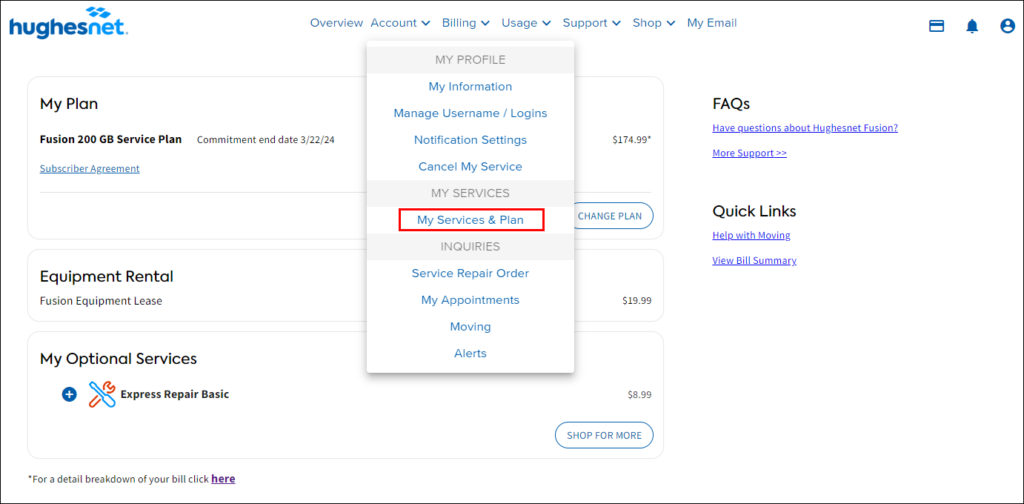
You may also contact Customer Care for help regarding your service plan. A Customer Care representative is available 24 hours a day at 866-347-3292.
Do I have other Hughesnet services?
From the same screen above you can view all of your active Hughesnet subscriptions.
How do I manage my services?
You can easily manage your services by clicking on the ‘Change Plan’ to the right of the product listing or the plus sign then ‘Manage’ or ‘Cancel My Subscription’ under ‘My Optional Services’.
Changes made to product subscriptions will be pro-rated on your billing statement effective as of the date you made the change.
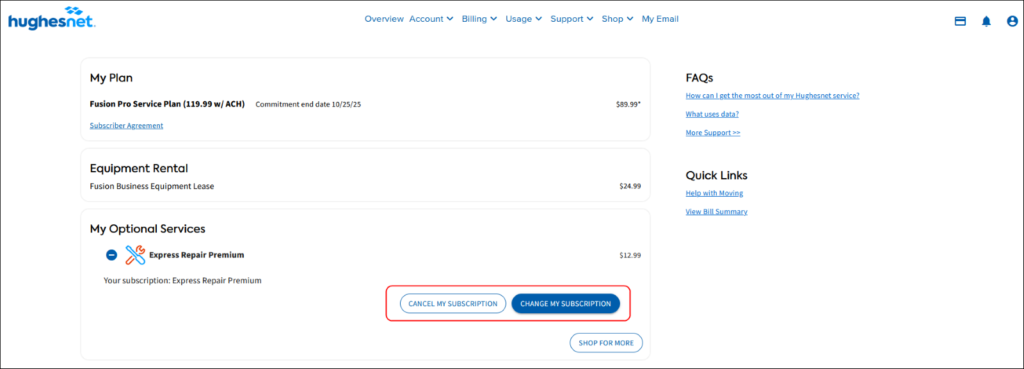
How do I add additional services to my account?
Learn more about Hughesnet Optional Services by clicking ‘Shop’ at the top of the page.
If you exceed your Service Plan Data, you will stay connected, but may experience reduced speeds until the next billing cycle. Data Tokens are a great way to restore your high-speed data.
Sign in or register on myhughesnet.com. Once logged-in, click on ‘Usage’ and ‘Data Token Purchase’ in the second menu.
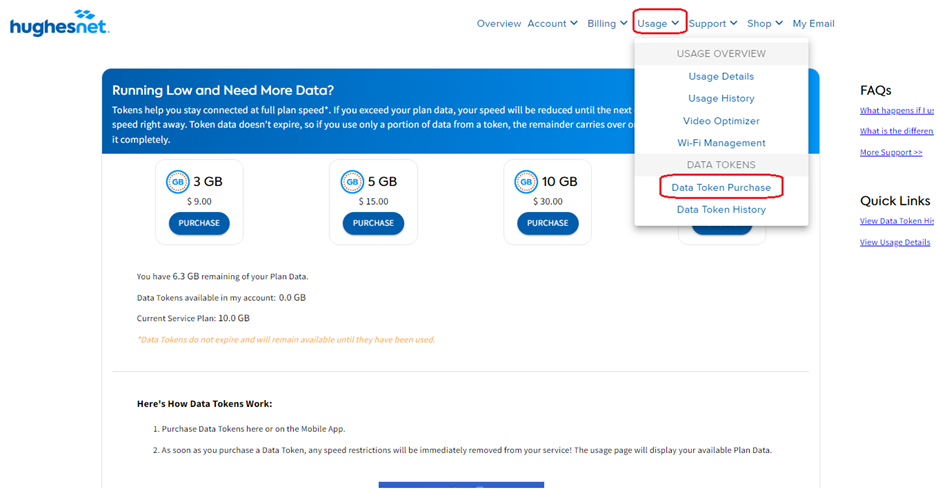
Download the myHughesnet (Mobile) App from your app store and enjoy easy account management at your fingertips. You can purchase Data Tokens from both the ‘Overview’ and ‘Usage’ screens.
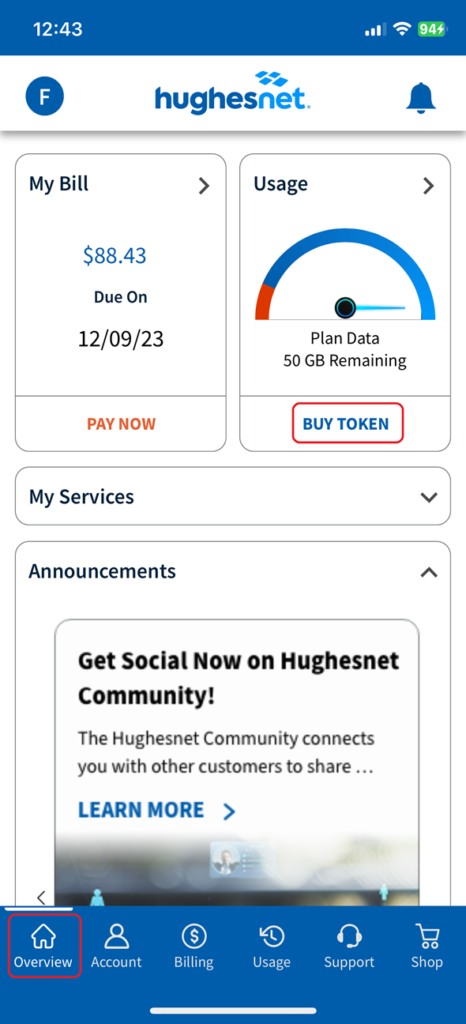
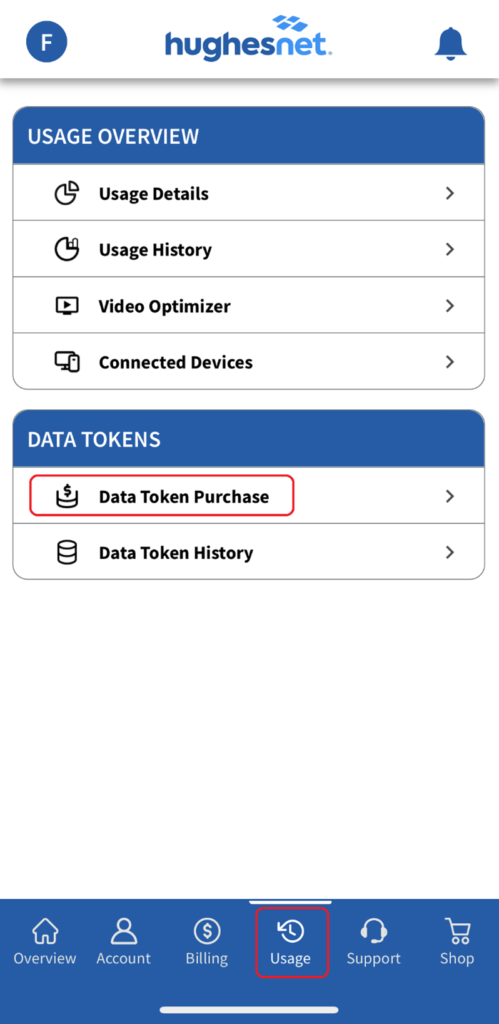
To ensure fair internet access for all Hughesnet® customers, Hughesnet maintains a special Fair Access Policy that establishes an equitable balance in internet access for all Hughesnet subscribers. Similar to how cell phone providers manage their data plans, all Hughesnet plans come with an allotment of data, that may be downloaded or uploaded within each monthly billing cycle. Subscribers who exceed this amount may experience slower speeds during high-traffic periods until their next billing cycle.
Here are some tips to optimize your data usage:
1. Enable Video Optimizer for optimized streaming experience up to HD quality.
2. Turn OFF devices when not in use
3. Schedule downloads/updates during Bonus Zone
For current Terms and Conditions and additional information, go to the Subscriber Agreement here.
If you have already registered on myhughesnet.com and have forgotten your Username and/or password, you can use the following FAQ article to gain access to your account.
Note: If you have not previously registered, click here for instructions on how to register.
Click on the links below to navigate to the respective section of the article:
1. If you have forgotten your Username, you can click the Forgot Username link found on the ‘Sign In’ screen.
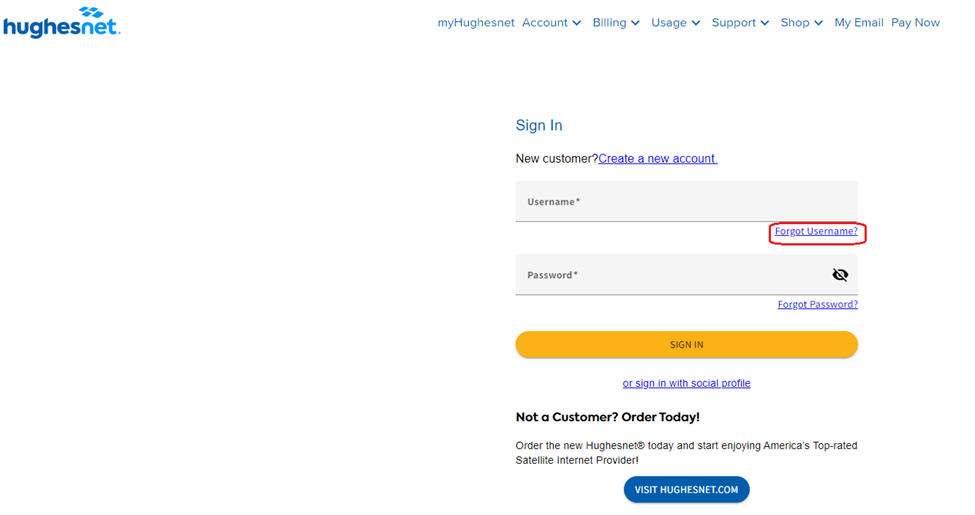
2. You will be required to enter your Site Account Number (SAN) and telephone number associated with your account before proceeding. If you do not know your SAN, you can find it on http://www.systemcontrolcenter.com (only when connected to your Hughesnet® internet), or on your monthly statement, or on your Order Confirmation email.
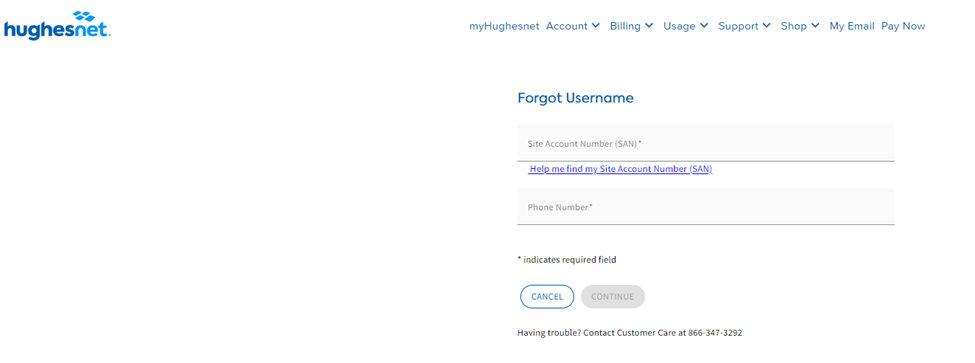
3. A list of Usernames associated with your account will display. Select the Username you want to login as and continue with the sign in process.
Step 1: If you have forgotten your Password, you can click the Forgot Password link found on the ‘Sign In’ screen.
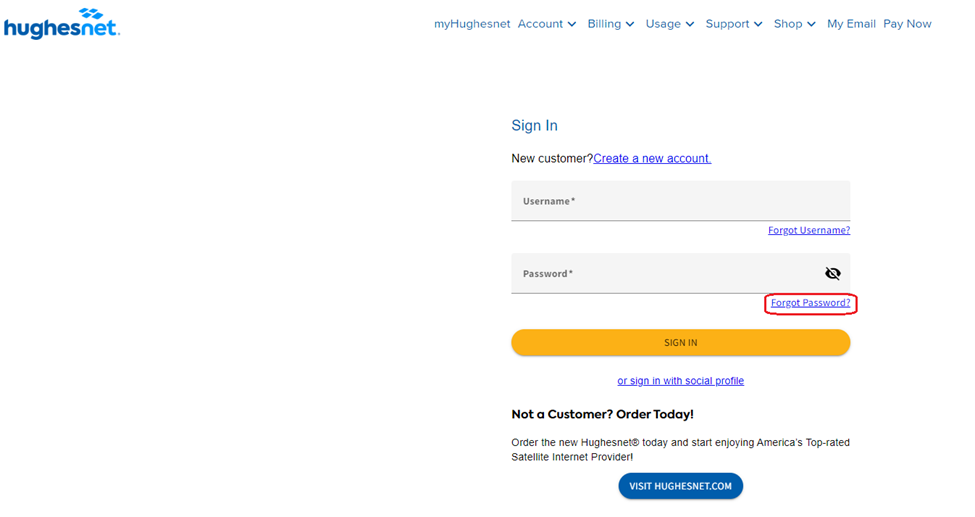
Step 2: Depending on whether a ‘Recovery Mobile Number’ was provided at the time of creating the account, or when you login later, you have two options to reset your forgotten password.
Option 1: “Recovery Mobile Number” is previously setup
You will be presented with two options to reset your password like the image below:
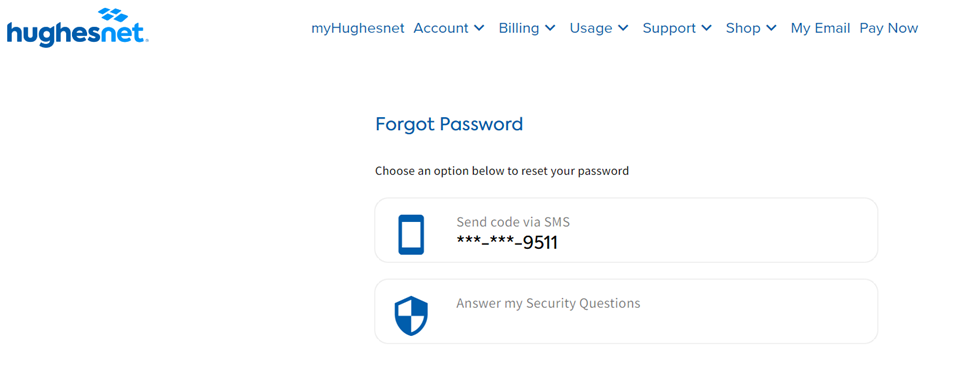
Option 2: No “Recovery Mobile Number” provided
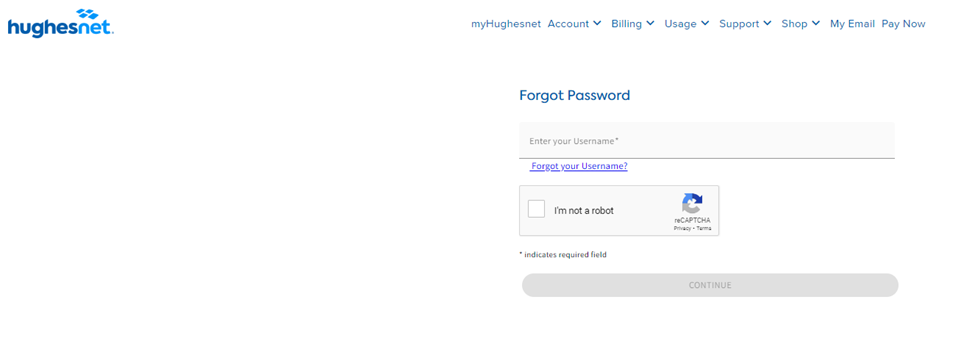
2. You will be asked to answer your pre-set security questions. You must correctly answer all of the questions to proceed. Answers are case-sensitive.
3. If you have not set your security questions, please contact Customer Care at 866-347-3292 for further assistance.
4. When you have successfully answered the security questions, you will be prompted to set your new password.
Other Related FAQs:
For instructions on setting up a recovery mobile number, click here.
Completing security questions ensures your online Hughesnet® account is secure and allows you to easily reset your password if forgotten.
The security questions and answers are an added feature for more secure access to your HughesNet account. If you forget your password, you can reset it online by answering the security questions you have chosen. Also, Single Sign On (SSO) functionality allows you to login to your account online and on the Hughesnet Mobile App.
You will be asked to verify your SAN and Daytime Phone Number if this is the first time you are logging in.
1. If you can login to myhughesnet.com, but forgot the answers to your security questions, you can reset your questions and answers by going to ‘Account’ and then ‘My Information’.
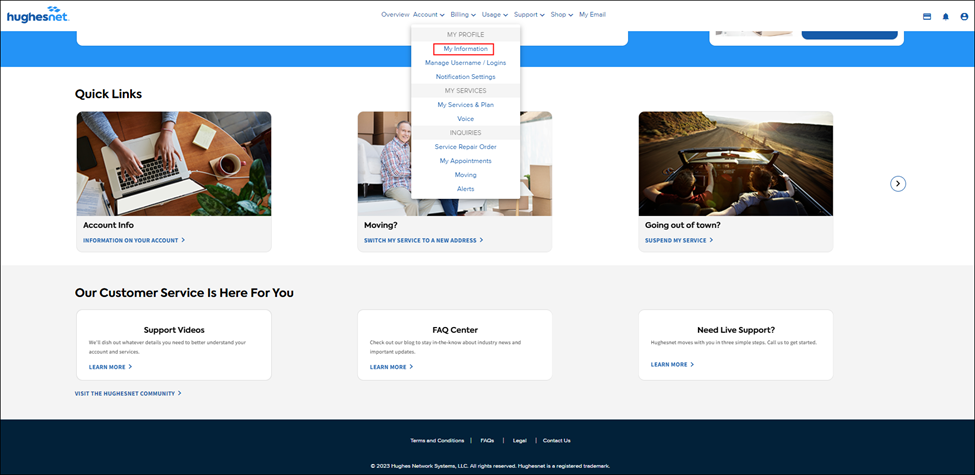
2. Under ‘Security & Password’, select ‘Manage’. The following screen prompts you to select your three security questions.
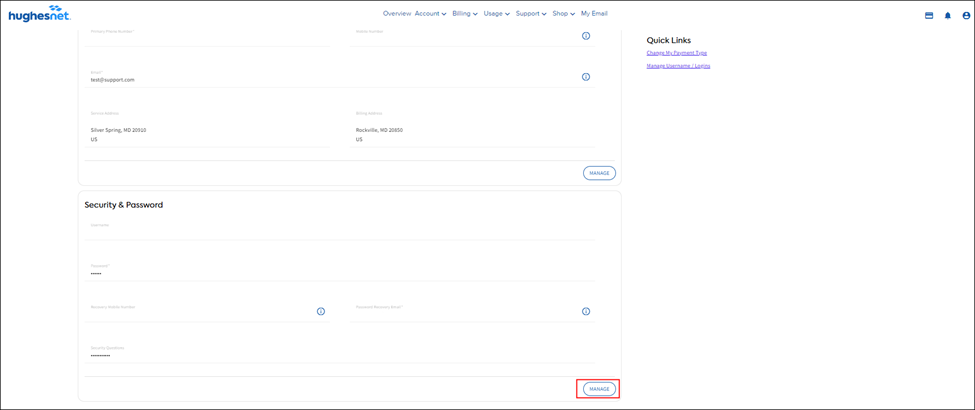
If you are unable to login to myHughesNet.com and forgot the answers to your security questions, please call Customer Support at 866-347-3292. A representative will be able assist you by resetting your password.
Home networks include everything connected to your Hughesnet® internet – from multiple computers to Wi-Fi devices such as tablets and smartphones. Learn more about Hughesnet home network capabilities.
You can connect multiple home computers and laptops to a single Hughesnet internet connection. Home networking equipment may be required and is not included with your Hughesnet system. For network setup, support, and configuration, contact your network hardware manufacturer and/or operating system software developer (Hughes is not responsible for home network configuration or management).
All computers on your network will share a single internet connection. This includes Wi-Fi devices such as tablets and smartphones as well.
You can wirelessly connect as many devices as you want to. However, several devices connected to your internet simultaneously may result in performance degradation. Hughesnet offers a variety of Service Plans to accommodate your internet usage needs. Click here to help find the right plan for you.
1) Sign in or Register at myHughesnet.com. Click on “Usage” and then “Data Token Purchase”.
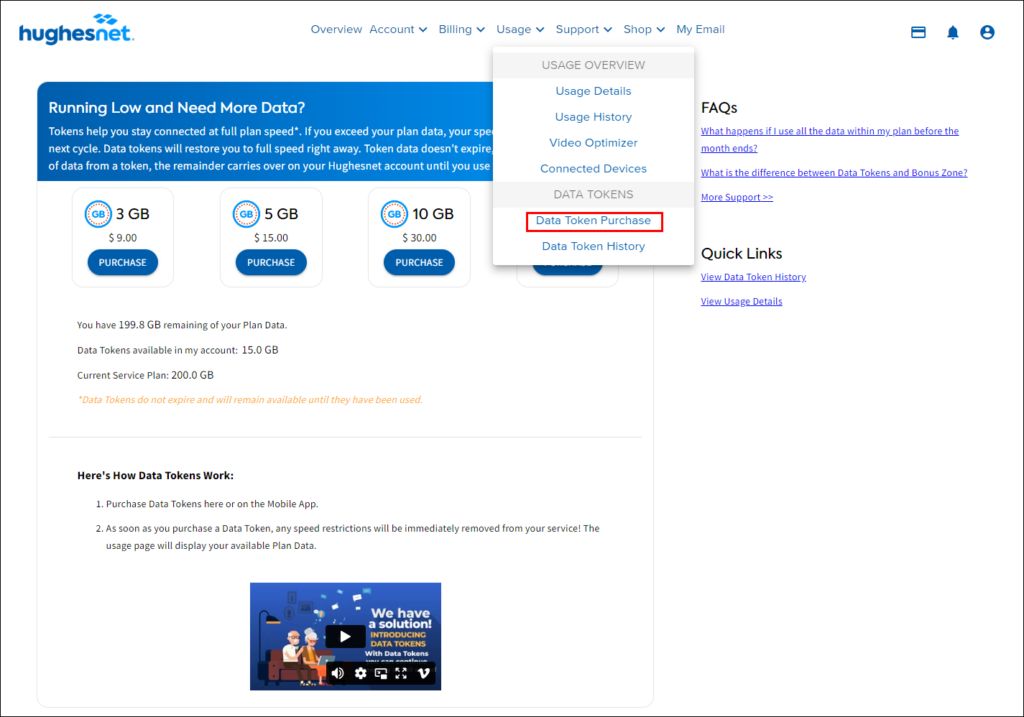
2) Select which Token you would like
3) The Data Token purchase window launches. This screen displays the Data Token you’ve selected. Click “Purchase”.